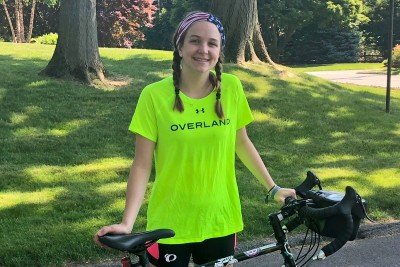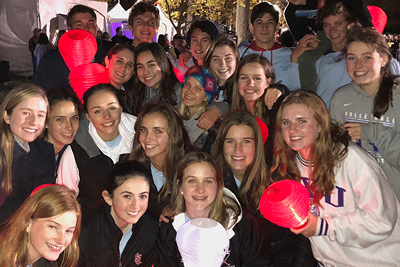How Leukemia Spurred Kate to Find Her Mission
Kate Stevens was diagnosed with a rare form of leukemia when she was only five years old. Chemotherapy and a bone marrow transplant wiped out her disease, and now she is off to Harvard University.

After completing treatment at MSK Kids, Kate Stevens took a bike trip across the country to raise money for leukemia research.
- Kate Stevens was just five years old when she was diagnosed with acute monocytic leukemia.
- Kate’s care team was led by MSK Kids’ Peter Steinherz, Neal Shukla, and Nancy Kernan.
- Inspired by her experiences, Kate and her family became involved with the Leukemia and Lymphoma Society (LLS).
- This past June, Kate took part in MSK Kids’ annual Pediatric Convocation and Commencement.
Kate Stevens was just five years old when she was diagnosed with acute monocytic leukemia in 2007. Now 18, Kate says that even at her young age, she knew something about her childhood was unusual.
Kate: There’s this idea that when you’re young you don’t remember much, but I think kids are sponges and there’s a lot you don’t forget. My time at MSK was essentially my childhood. I don’t think I knew the extent of how sick I was; I was happy except when I was getting shots.
Kate’s care team was led by MSK Kids’ pediatric oncologists Peter Steinherz and Neal Shukla. They decided that chemotherapy followed by a bone marrow transplant would give Kate the best chance of overcoming her illness.
Dr. Steinherz: Her gums had been swollen for a couple of weeks. They weren’t getting better and when she had a blood test, she had a very high number of white blood cells. The numbers were so high that they indicated to us that her body was fighting more than an infection. When we looked even closer, we saw that she had many circulating leukemic cells. We determined that she had a subtype of acute myeloid leukemia (AML) called acute monocytic leukemia. It’s treated similarly, but it behaves differently.
Dr. Shukla: I remember having really good interactions with her family. Kate’s parents were very physically active, so I had no doubt Kate would become an athlete as well. The number one goal, of course, was to cure her, but we wanted to reduce the side effects of her treatment as much as possible so she could follow in their footsteps.
Moving the Curve
The chemotherapy put the cancer into complete remission, which means that Kate had no visible leukemia cells left. However, chemotherapy may not always permanently wipe out this disease. Some children need a bone marrow transplant to help prevent the disease from coming back. Kate needed a donor whose white cell typing, a very precise form of blood categorization, was compatible with hers.
Each of her siblings only had a 25 percent chance of being a match for a bone marrow transplant. Thankfully, Kate’s four-year-old sister Caroline was indeed a match. Kate underwent a bone marrow transplant in November 2007 with Nancy Kernan, Assistant Chief of MSK’s Pediatric Stem Cell Transplantation and Cellular Therapies Service.
Kate: I owe my life to Caroline, literally.
Dr. Kernan: Kate had a higher chance of her disease coming back if we treated her with chemotherapy alone. A BMT helps the disease stay in remission and increases the chance of long-term survival. Since Kate had a matched sibling, we recommended the BMT, because her long-term survival rate jumped from 40 percent to almost 80 percent.
The transplant was a success. Kate stayed in remission and now she only comes to MSK for annual check-ups with our Long-Term Follow-Up Team. She maintains ongoing relationships with her care team.
Dr. Kernan: Her family wanted her to remember the transplant and appreciate what was done for them. They still send me Christmas cards and emails updating me on her progress. Pediatric inpatient nurse Maryeliza McEchen is also still very close to Kate and her family.
Dr. Steinherz: I try to give Kate a hug every time I see her in the waiting room.
Paying It Forward

Kate (holding white balloon) has been an ardent supporter of the Leukemia and Lymphoma Society.
Inspired by her experiences, Kate and her family became involved with the Leukemia and Lymphoma Society (LLS). Every year since Kate started treatment, her family has participated in the LLS’s signature fundraising event, the Light the Night walk. During the two-mile organized stroll, participants carry lanterns to symbolize their mission to overshadow the darkness of cancer.
Kate: When I was 15 I created a Light the Night team. In 2016, the LLS asked me to be their Honored Hero, which meant I spoke at various events. That year, I also fundraised for a bike ride I wanted to take across the country. After many discussions with my parents and doctors about whether my body could handle it, in 2018 I rode 3,200 miles from Charleston, South Carolina, to Santa Monica, California. I was able to live out this dream, and every kid deserves that chance. I chose to direct the money I raised to pediatric leukemia research and was featured in a journal article about its findings.
Dr. Shukla: Knowing how strong Kate is both mentally and physically, her bike ride across the country didn’t surprise me at all.
Kate’s motivation to give back didn’t stop there. In 2019 she held a summer internship at MSK, working both in research and patient care.
Kate: I did research with Renier Brentjens, who studies immunotherapy treatments for cancer. I also shadowed leukemia expert Ellin Berman and watched as she took care of patients. Pediatric oncologist Kevin Curran was one of the doctors who took care of me when I was a kid, and I shadowed him as well. I hadn’t been to the hospital’s inpatient unit since I was admitted for my transplant. Even just walking in and smelling the place brought back a wave of emotions. That was really hard, but also really powerful.
One other highlight of my summer was when I saw Dr. Kernan in the hallway. I hadn’t seen her in years, but I immediately recognized her. I gave her a big hug.
Dr. Kernan: I was walking down the hallway and we caught each other’s eyes. It’s very heartwarming to see a former patient not only doing well but also thriving.
The internship taught her about more than just medicine, though.
Kate: Doing research and also seeing patients showed me how interconnected the two fields are. It made me realize that I want to do both. All of my doctors played such integral parts of my life. I want to go into medicine because of them and my experiences at MSK.
A Bright Future
Kate was her school’s student body president, salutatorian, and field hockey team captain. This past June, she took part in MSK Kids’ annual Pediatric Convocation and Commencement, which celebrates current and former patients graduating from high school. Due to COVID-19, the event took place virtually. But the impact was still strong.
Kate: It was a special morning. I loved seeing all of us dressed in caps and gowns and realizing we all had similar experiences. All of us are bonded in a way no one really wants to be bonded in but seeing us take this next step and pioneer our futures was powerful.
Kate plans to be pre-med when she starts at Harvard University in the fall.
Kate: Cancer is just a small part of my life. It doesn’t have to be everything. It helped make me who I am, but it is by no means who I am. I would tell a younger version of myself to just keep hoping and dreaming. There are a lot of dark times when you’re sick, but hope can go a long way.
Dr. Kernan: Many of our former patients choose to go to medical or nursing school because they’ve been there, know the dark days, and want to help other children get through their treatment and pursue their dreams.
Dr. Shukla: I hope she gets to explore all the different parts of medicine and that her experience as a patient helps guide her. The sky’s the limit for her.


